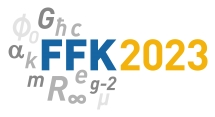Speaker
Description
The ASACUSA-CUSP experiment located at CERN’s antiproton decelerator aims at measuring the ground state hyperfine splitting of antihydrogen (H̄) using a beam technique to test CPT symmetry. For this purpose, a beam of cold (~50K) hydrogen has been developed to characterize the antihydrogen spectroscopy apparatus [1]. Beyond serving as a test bench for the H̄ experiment, the hydrogen beamline offers on its own a variety of possible measurements especially in the context of the Standard Model Extension (SME). The SME is an effective field theory that allows CPT and Lorentz symmetries to be broken [2]. A precise measurement of the hydrogen ground state hyperfine splitting was realized in 2017 using the extrapolation of a single hyperfine transition (σ1) reaching a relative precision of 2.7 ppb [3]. Since then several additions to the setup were made allowing the precise measurement of the π1 transition which provides sensitivities to some SME coefficients [4, 5]. A new measurement campaign on hydrogen started in 2022 and focused on π1 precision measurements with swapping external magnetic fields using the σ1 transition as a reference to constrain SME coefficients. An overview on the underlying theory and the experimental setup will be provided. The blind analysis of the collected data is effectively completed, and the contributions to the error budget, as well as peculiar effects originating from the static magnetic field, will be presented.
